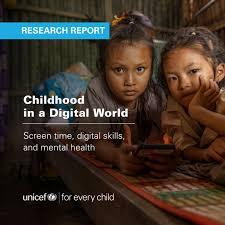
JUNE 2025
https://www.unicef.org/innocenti/reports/childhood-digital-world
Thirty years ago, digital connectivity was limited to a few million people around the world. Since then, the digital revolution has swept the globe and today nearly five billion people are connected. In many countries, digital technologies have been rapidly adopted by children. The internet is no longer a luxury for children, but has become necessity for playing, keeping in touch with friends and family, learning and building skills for the future.
With the mainstreaming of the internet, the value of learning digital skills from an early age has become increasingly apparent. The first step to developing digital skills is to access the internet and use digital technologies. Though internet access has improved considerably around the world, enormous gaps persist. An estimated two thirds of the world’s school-aged children – or 1.3 billion children of ages 3 to 17 years – do not have internet access at home. Most of these children live in parts of Africa and Asia. Children without connectivity are at a disadvantage in the global rush to acquire digital competencies.
And yet, children not having digital access and falling behind on digital skills is only one side of the coin. In high-connectivity countries where access has become nearly universal, children face other challenges. Reports of rising mental health issues among young people have drawn scrutiny about the impacts of frequent internet use and the spread of online games, smartphones and social media.
Despite the internet’s potential to transform lives for the better, our collective understanding of how children’s digital use and experiences impact their skills and mental health remains limited. With countries in varying stages of digital development, it has been difficult to establish a global picture of who is online and who is not, why some children possess digital skills while others do not and how digital technology impact children’s mental health. Too often the voices and lived experiences of children get lost in the mix when companies and other powerful stakeholders race to build a profitable and captivating digital world.
Key facts
Key facts
Conclusions and recommendations
Conclusions and recommendations
Highlights
This report describes the evolving landscape of children’s digital lives, documenting what we know about their access, digital skills and impacts on mental health. Presenting global and comparative data that have not been previously analysed together, it explores how lack of digital access can influence a child’s digital skills development and highlights the potential for digital technology to exacerbate inequalities. The report also responds to ongoing debates about screen time by providing robust evidence on when and how digital technologies can undermine children’s mental health.
We hope the report will contribute to a better balance in the current discourse on children’s use of digital technologies by demonstrating how digital technology has the potential to impact children both positively and negatively, depending on how they use it, and what kind of content and experiences they are exposed to. Finally, we suggest solutions to ensure that children in the future will be able to spend time online to play, build skills and explore the internet while staying safe.
We have a responsibility to ensure all children can benefit from the promises of digital technology while protecting them from its perils. Societies can only benefit when children have digital skills and are able to navigate online opportunities and manage the risks. This is also in the best interests of children, who have a right to play, learn and be safe in an online world.









